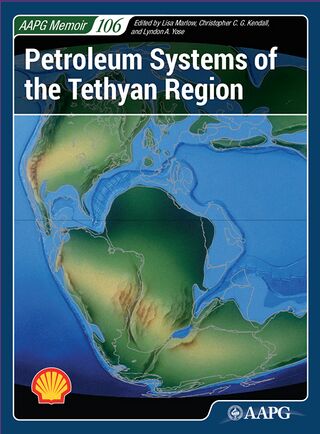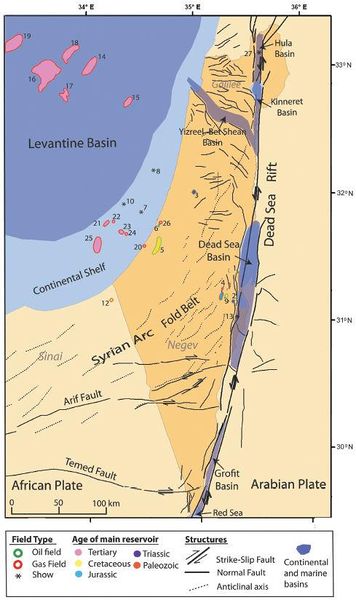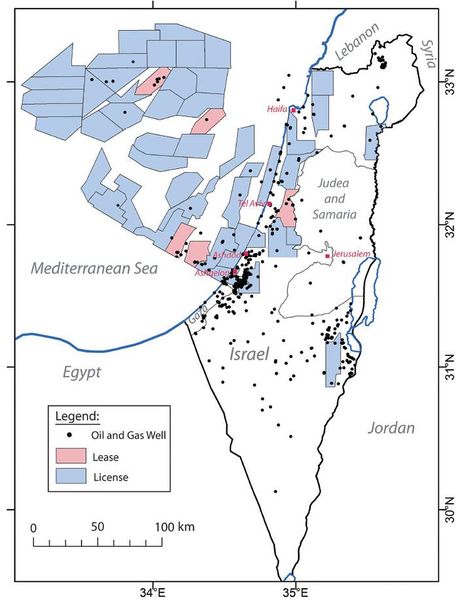Israel petroleum systems
| Petroleum systems of the Tethyan region | |

| |
| Series | AAPG Memoir |
|---|---|
| Chapter | The petroleum systems of Israel |
| Author | Michael A. Gardosh, Eli Tannenbaum |
| Link | Web page |
| Store | AAPG Store |
Petroleum has been exploited in the area of Israel since times of antiquity.[1] Remains of asphalt collected along the Dead Sea shore were identified in Egyptian mummies dated to about 200 B.C.[2] Modern commercial exploitation of hydrocarbons began in the 1950s with the discovery of the Helez oil field in the southern Coastal Plain of Israel (Figure 1). The Helez success promoted drilling activity throughout the country, but until the 1990s only small quantities of oil and gas had been discovered and produced. In 1999 the focus of exploration was shifted from the onshore systems to the Levantine Basin (Figure 1). In the following decade, 11 natural gas fields were discovered offshore Israel in water depths ranging from 200–1600 m (656–5249 ft). One of them, the MariB field (Figure 1), began production in 2004 and the Tamar field in 2013.
Figure 1 Map showing the main tectonic elements and petroleum occurrences of Israel. The two most prominent tectonic features are the Levantine Basin and Margin in the west and the Dead Sea rift in the east. Most of the hydrocarbon accumulations found in Israel are associated with these two tectonic provinces. Other important structural elements are the Syrian Arc fold belt in central and southern Israel, the Sinai-Negev dextral, strike-slip faults, and the normal fault system of the Galilee. Numbers refer to oil fields and hydrocarbon shows detailed in Table 1. 50 km (31.1 mi).
| Age | Field or Show # (show=*) | Field or Show Name | Petroleum System | Year of Discovery | Reservoir Name or Formation | Reservoir Type | Hydrocarbon Type | Trap Type | Source Rock | Seal Rock | Produced by 2001 (MMBO &/or BCFG) | Recoverable Resources (MMBO &/or BCFG) |
|---|---|---|---|---|---|---|---|---|---|---|---|---|
| Quaternary | 27 | Hula | Hula | 1991 | Huyla Sand | Continental sandstone, coal | Gas | Structural/stratigraphic | Hula Formation | Hula marl | 0.01 | 0.2 |
| 26 | Ashdod Gas | Yafo | 1976 | Kurkar Yafo | calcarenite | Gas | Stratigraphic | Saqiye Group | Saqiye Group | 0.37 | 1.5 | |
| Pliocene | 25 | Gaza Marine | Yafo | 2000 | Yafo Sand | Turbidite sandstone | Gas | Stratigraphic | Saqiye Group | Yafo shale | U.F. | 1200 |
| 24 | Nir | Yafo | 2000 | Yafo Sand | Turbidite sandstone | Gas | Structural/stratigraphic | Saqiye Group | Yafo shale | U.F. | 4 | |
| 23 | MarieB | Yafo | 2000 | Yafo Sand | Turbidite sandstone | Gas | Structural/stratigraphic | Saqiye Group | Yafo shale | 770 | 1200 | |
| 22 | Or | Yafo | 1999 | Yafo Sand | Turbidite sandstone | Gas | Stratigraphic | Saqiye Group | Yafo shale | U.F. | 35 | |
| 21 | Noa | Yafo | 1999 | Yafo Sand | Turbidite sandstone | Gas | Stratigraphic | Saqiye Group | Yafo shale | U.F. | 42 | |
| 20 | Shiqma | Yalo | 1978 | Shiqma Sand | Shoreline sandstone | Gas | Stratigraphic | Saqiye Group | Yafo shale | 1.4 | -1.4 | |
| Miocene | 19 | Aphrodite | Tamar | 2011 | Tamar Sand | Turbidite sandstone | Gas | Structural | Saqiye Group | Mavqiim Evaporites | U.F. | 3000 |
| 18 | Tanin | Tamar | 2011 | Tamar Sand | Turbidite sandstone | Gas | Structural | Saqiye Group | Mavqiim Evaporites | U.F. | 600 | |
| 17 | Dolphin | Tamar | 2011 | Tamar Sand | Turbidite sandstone | Gas | Structural | Saqiye Group | Mavqiim Evaporites | U.F. | 80 | |
| 16 | Leviathan | Tamar | 2010 | Tamar Sand | Turbidite sandstone | Gas | Structural | Saqiye Group | Mavqiim Evaporites | U.F. | 17000 | |
| 15 | Dalit | Tamar | 2009 | Tamar Sand | Turbidite sandstone | Gas | Structural | Saqiye Group | Mavqiim Evaporites | U.F. | 270 | |
| 14 | Tamar | Tamar | 2008 | Tamar Sand | Turbidite sandstone | Gas | Structural | Saqiye Group | Mavqiim Evaporites | U.F. | 9000 | |
| 13* | Amiaz | Dead Sea | 1990 | Hazeva Sand | Continental sandstone | Heavy oil | Structural | Mt. Scopus Group | Sedom Evaporites | |||
| Late Cretaceous | 12 | Sadot | Yafo | 1977 | Judea | Shelf carbonate | Gas | Structural | Saqiye Group | Saqiye Shale | –30 | –30 |
| 7* | Yam | Yam | 1989 | Gevaram Sand | Turbidite sandstone | Gas | Structural | Unknown | Gevaram shale | |||
| Early | 8* | Yam Yafo | Yam | 1994 | Gevaram Sand | Turbidite sandstone | Gas | Structural | Unknown | Gevram shale | ||
| Cretaceous | 10* | Yam West | Yam | 1994 | Gevaram Sand | Turbidite sandstone | Gas | Structural | Unknown | Gevaram shale | ||
| 9 | Gurim | Dead Sea | 1983 | Hatira Sand | Continental sandstone | Heavy oil | Structural | Mt. Scopus Group | Judea Carbonate | 0.009 | –0.009 | |
| 5 | Helez | Helez | 1955 | Helez | Shoreline sandstone | Oil | Structural/stratigraphic | Barnea Formation | Talme Yafe marl | 17.4 | 19 | |
| Late Jurassic | 5 | Helez | Helez | 1955 | Nir'am | Shelf carbonate | Oil | Structural | Barnea Formation | Talme Yafe marl | 17.4 | 19 |
| 8* | Yam Yafo* | Yam | 1994 | Carbonate gravity-flow | Oil | Structural | Unknown | Gevaram shale | ||||
| Middle Jurassic | 7* | Yam | Yam | 1989 | Carbonate gravity-flow | Oil | Structural | Unknown | Gevaram shale | |||
| 6 | Ashdod | Helez | 1976 | Zohar | Shelf carbonate | Oil | Structural | Barnea Formation | Kidod shale | 0.213 | 1 | |
| 5 | Helez | Helez | 1964 | Brur | Shelf carbonate | Oil | Structural | Barnea Formation | Gevaram shale | 17.4 | 19 | |
| 4 | Zohar/Kidod/Kanaim | Dead Sea | 1957 | Zohar | Shelf carbonate | Gas | Structural | Mt. Scopus Group | Kidod shale | 73 | –73 | |
| Late Triassic | 3 | Meged | Meged | 1994 | Mohilla | Shelf carbonate | Oil | Structural | Unknown | Mohila anhydrite | 0.13 | 2.2 |
| Middle | 1 | Emunah | Dead Sea | 1995 | Gevanim | Shoreline Sandstone | Oil | Structural | Mt. Scopus Group | Mohila anhydrite | 0.013 | –0.013 |
| Triassic | 2 | Zuk Tamrur | Dead Sea | 1994 | Raaf | Shelf carbonate | Oil | Structural | Mt. Scopus Group | Mohila anhydrite | 0.13 | –0.15 |
| Permian | 1* | Emunah | Dead Sea | 1995 | Saad/Arkov | Continental sandstone | Oil | Structural | Mt. Scopus Group | Arkov shale |
The 60-year-old story of Israel’s petroleum industry is one of many rises and falls. Periods of drilling success were followed by dry wells and suspension of exploration activity, at times influenced by geopolitical instability, unfavorable fiscal regime, and lack of capital investment. Once government owned, the three Israeli oil companies, INOC (Israel National Oil Company), Naphta, and the Lapidoth Oil Prospectors, were fully privatized during the 1990s.
The recent, offshore drilling success has attracted major capital investment and has resulted in a surge of exploration activity (Figure 2) with the participation of internationally based oil companies. In the coming decade new targets will be drilled in the Levantine Basin offshore Israel which may lead to an increase in gas reserves and possibly prove the potential for the production of oil, previously discovered in several offshore wells (Figure 1). For the first time in its history, Israel has the prospect of supplying its own energy needs and even becoming an exporter of natural gas.
See also
- Phanerozoic Tethys region
- Tethys region
- Libya hydrocarbon provinces
- Jordan petroleum geology
- Iraq petroleum geology
- Iran petroleum systems
- Petroleum basins of Turkey
References
- ↑ Nissenbaum, A., 1978, The Dead Sea asphalts - Historical aspects: AAPG Bulletin, v. 62, p. 837–844.
- ↑ Rullkötter, J. and A. Nissenbaum, 1988, Dead Sea asphalt in Egyptian mummies: Molecular evidence: Naturwissenschaften, v. 75, p. 618–621.

